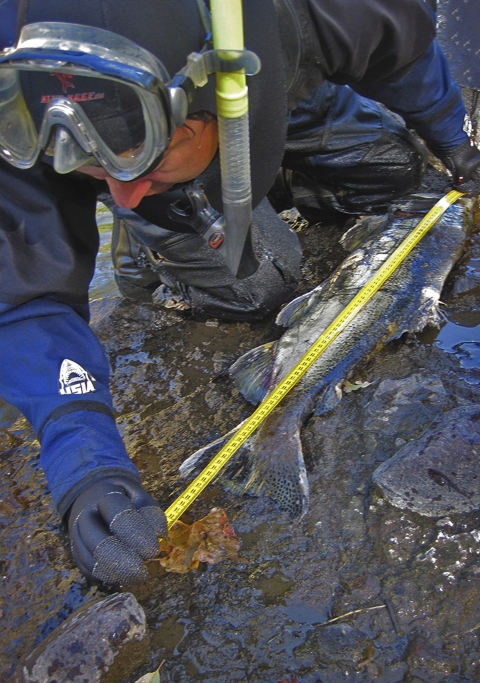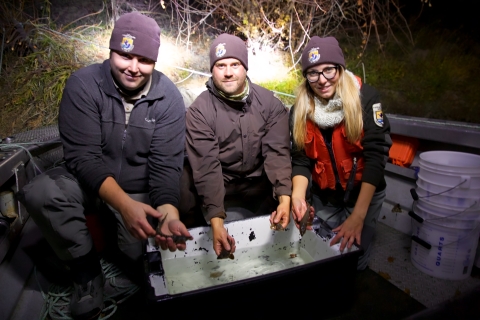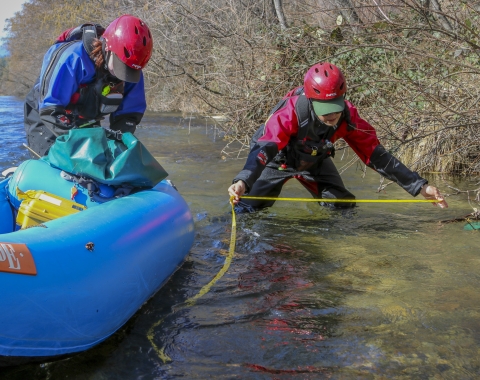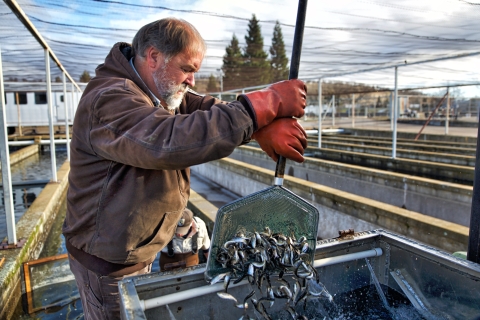What We Do
Our Office provides biological expertise and assistance to entities seeking to conserve and protect the ecosystems of north-central California. Our offices are just south of the Red Bluff Diversion Dam on the Sacramento River.
Our specific objectives are to:
- Protect anadromous salmonid spawning populations in the Sacramento River system in order to stabilize or increase fish runs;
- Improve the effectiveness of the federal anadromous fish propagation facilities in California, Coleman and Livingston Stone National Fish hatcheries;
- Protect and restore the productivity of natural habitats in the Sacramento River system;
- Continue the development of information and strategies for protecting the natural habitats of the Sacramento River system as migration routes, nursery areas and spawning areas for anadromous fish species; and
- Provide Endangered Species Act consultation.
Our Projects and Research
Hatchery Evaluation Program
The hatchery evaluation program supports the efforts of Coleman National Fish Hatchery and Livingston Stone NFH to meet fish production goals, maximize contributions to fisheries, minimize negative impacts to naturally produced fish populations and conserve species. Together, Coleman NFH and Livingston Stone NFH propagate three runs of Chinook salmon and steelhead. Fall and late-fall Chinook salmon and steelhead are propagated at Coleman, and endangered winter Chinook salmon are propagated at Livingston Stone. About 12 million fall Chinook Salmon, 1 million late-fall Chinook Salmon, and 600,000 steelhead are produced at Coleman annually, while Livingston Stone produces up to 250,000 endangered Sacramento River winter Chinook salmon each year. Learn more by visiting Red Bluff's Hatchery Evaluation Program webpage.
Sacramento River Natural Origin Chinook Salmon Acoustic Tagging Project
Current efforts are underway to learn migration survival information on naturally produced Chinook salmon in the upper Sacramento River sampled at Red Bluff Diversion Dam. Red Bluff is actively working with the National Marine Fisheries Service, Army Corps of Engineers and U.S. Geological Survey using a Juvenile Salmon Acoustic Telemetry System to gather habitat use and migration data. This study is unique because it provides insight on survival, travel time and distribution of naturally produced fish. Additionally, if smaller tags can be obtained in future years, smaller size classes and larger numbers of winter Chinook Salmon smolts may be used in this study. Data from tagged individuals can be accessed through the National Oceanic and Atmospheric Administration's CalFishTrack website.
Green sturgeon life history research and monitoring
Starting in 2016, efforts to learn basic life history information on this threatened population expanded the juvenile green sturgeon monitoring work, and uses benthic trawls to capture fish of sufficient size for micro-acoustic tagging. Current efforts include collaborative work on juvenile green sturgeon in-river habitat use and migration to determine entry timing and cues to the Sacramento-San Joaquin River Delta. USFWS is actively working with NMFS, ACOE and others using JSATS technology to gather habitat use and migration data. Data from tagged individuals can be accessed through the National Oceanic and Atmospheric Administration's CalFishTrack website. Learn more on Red Bluff's webpage about green sturgeon life history research and monitoring.
Anadromous Fish Restoration Program
Legislation passed in 1992 established the Anadromous Fish Restoration Program to increase naturally produced populations of anadromous fish in California's Central Valley streams on a long-term, sustainable basis. Under AFRP, Red Bluff works with partners and willing landowners on projects that will help protect and restore natural channel and riparian riparian
Definition of riparian habitat or riparian areas.
Learn more about riparian habitat values through habitat restoration actions. Red Bluff staff working under the guidance of the AFRP have implemented over 195 projects to restore natural production of anadromous fish. Find out more on Red Bluff’s Anadromous Fish Restoration Program webpage.
Red Bluff Diversion Dam Juvenile Fish Monitoring
The juvenile monitoring program gathers bi-weekly, real-time daily passage estimates of all four runs of Chinook salmon and steelhead. Passage data are provided to water managers at the Central Valley Project's Tracy Pumping Plant and the State Water Project's Harvey Banks Delta Pumping Plant to minimize the number of juvenile winter Chinook salmon that are caught or diverted by the facilities’ water-pumping systems. The data are accessible from the Central Valley Prediction and Assessment of Salmon website. Learn more on our Red Bluff Diversion Dam Juvenile Fish Monitoring page.
Battle Creek Restoration and Monitoring
Battle Creek is an important watershed for the conservation and recovery of federally listed species of anadromous salmonids. The Red Bluff Fish and Wildlife Office has been conducting monitoring in the drainage for the past three decades. These efforts, in conjunction with the Battle Creek Salmon and Steelhead Restoration Project, focus on studying the effects of stream restoration, dam removal, new fish ladder construction and water acquisition projects in order to promote access to holding, spawning and rearing habitats critical to survival and recovery of Central Valley salmonids. The areas we study on Battle Creek can be viewed on this map.
Clear Creek Restoration and Monitoring
Restoring salmonid habitat in Clear Creek is an important element within the Central Valley Project Improvement Act’s goal of doubling populations of anadromous fishes. Restoration has focused on improving habitat for all life stages of anadromous fishes, through gravel supplementation, instream flow management, floodplain and stream channel augmentation, and revegetation efforts. The Red Bluff Fish and Wildlife Office has been monitoring the success of these actions since 1995, using a variety of methods, including a video weir, snorkel and kayak surveys, gravel and habitat mapping, temperature tracking and rotary screw traps.
Winter-run Chinook salmon reintroduction to Battle Creek
One component of the Battle Creek Salmon and Steelhead Restoration Project is to provide habitats to support endangered winter-run Chinook salmon and establish a second population outside the Sacramento River. Since natural colonization is unlikely, human intervention is necessary, and a plan was developed to reintroduce winter-run Chinook to Battle Creek. The project is underway, and since 2018 there have been releases of hatchery-produced winter-run juvenile Chinook salmon and monitoring of adult returns. This is a collaborative effort of the Red Bluff Fish and Wildlife Office and Coleman National Fish Hatchery. The salmon-release sites, natural and human-made barriers, and locations of acoustic and radio receivers can be seen on this map.










